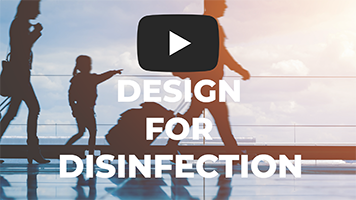The Facts on Disinfecting with UV Light

Disinfecting with UV light is a very popular and very important topic amidst these pandemic times. Here are some resources for lighting professionals and for the general public to better understand the science behind disinfecting with UV light.
While scientists, public health officials and government leaders around the world work hard to address the pandemic, it’s important and sensible for them to explore every practical option and remedy available that could potentially help fight COVID-19.
Enter Germicidal Ultraviolet light. Or GUV.
GUV technology has been utilized for decades in various applications. In recent years it has been gaining more and more traction in the lighting industry being offered in specialty fixtures for healthcare, education and food & beverage applications, among others.
When a niche technology is suddenly thrust into the spotlight as a potential combatant to a global pandemic, it spawns many factual reports – but also many less-scientific and anecdotal descriptions of how GUV light could be utilized to help the world fight a pandemic.
We’ve reviewed much of the information that has been recently published on the GUV topic and have collected some of our favorite resources here that can help both technical lighting people and non-lighting-minded citizens better understand the manner in which GUV light can help right now.
All of the resources stem from the same highly credible source: Illuminating Engineering Society Photobiology Committee. Let’s dig into what the experts report.
For a detailed, technical GUV overview
The IES has long been the go-to trusted resource for all topics relating to the science of illumination. In April, the IES Photobiology Committee issued a thorough 24-page report entitled “Germicidal Ultraviolet (GUV) – Frequently Asked Questions” that addresses many of the most relevant aspects of GUV lighting application. For technical lighting professionals and scientists it is a great guide that can help all of us work together on solutions.
Two resources to help us better understand key takeaways of the IES Report
Recently, we’ve come across two resources that can help further spread a consistent factual message of GUV technology and its applications. One is an explainer video and the other is a report from the journal of the IES.
The Explainer Video
Lytei founder, Sam Koerbel, has a knack for breaking down complex lighting principles into easily understood concepts. An alum of the University of Colorado Architectural Engineering and Lighting program, Sam recently produced a short video that can help us better understand the basics of GUV.
We spoke with Sam last week and he confirmed that all of the GUV facts cited in the video were pulled from the aforementioned IES reports. Also, even though the video is sponsored by Cooper Lighting Solutions, Sam stated that he was given full autonomy to craft the scientific explanation that he presents in the video. Take a look at the video and share it with some of your non-lighting friends and neighbors who’ve been discussing UV light with you recently.
The LEUKOS report
Kevin Houser is one the most trusted voices in lighting. He has enriched many students throughout his career in academia and has also been extremely active in making valuable contributions to various lighting organizations like the IES and International Association of Lighting Designers (IALD.) Kevin is currently a Professor at Oregon State University and Editor-in-Chief of LEUKOS, The Journal of the Illuminating Engineering Society. Furthermore, he is Chief Engineer at the Pacific Northwest National Laboratory (PNNL.)
LEUKOS recently published Kevin’s “Ten Facts about UV Radiation and COVID-19.” The ten facts are succinct and based on the recent IES GUV report. We believe it should be required reading for anyone seeking to better understand lighting’s role in addressing the current pandemic. (Reprinted with permission from the IES.)
Ten Facts about UV Radiation and COVID-19
By: Kevin W. Houser
The COVID-19 pandemic has generated interest in the potential of ultraviolet (UV) radiation to disinfect air and surfaces. In response, the IES Photobiology Committee published a freely available report about germicidal ultraviolet radiation (IES 2020). As an even-handed treatment of UV radiation’s potential and limitations, the report is a welcomed counterpoint to information appearing in social media feeds, the popular press, and in shady sales literature. Below are ten facts about UV radiation and COVID-19.
- The International Commission on Illumination subdivides the UV spectrum into three bands based on wavelength (CIE 2020). UV-C radiation is from 100 to 280 nm, UV-B from 280– 315 nm, and UV-A from 315 to 400 nm. UV-C is most effective for viral sterilization and is the primary tool for disinfecting air and surfaces. Germicidal ultraviolet radiation (GUV) and UV germicidal irradiation (UVGI) from electric light sources are almost always based on UV-C radiation.
- The SARS-CoV-2 virus can be rendered noninfectious with the application of UV-C radiation. This is because UV-C radiation damages its RNA sequence, breaking its bonds in a way that stops its ability to replicate. Colloquially, it may be said that UV-C radiation “kills” the virus that causes COVID-19.
- Though sunlight does not contain UV-C, if conditions are right it contains enough UV-B to inactivate the SARS-CoV-2 virus. When daylight has a UV index of 10, which could occur on a clear summer day when the sun is high in the sky, it may take an hour or so to achieve 99.9% inactivation. Sunlight is not a panacea because the SARS-CoV-2 virus remains viable in respirated droplets and on surfaces for up to an hour even when exposed to intense direct sunlight.
- If the type of UV radiation under discussion is harmful to bacteria and viruses, then it is also harmful to human skin and eyes. UV-C radiation should not be used to disinfect the hands or other body parts. Care should be taken to avoid skin and eye exposure.
- The reverse is also true. Sources that produce UV-A, including blacklights and UV insect traps, are not appreciably harmful to people or the SARS-CoV-2 virus.
- Viral inactivation from UV-C radiation can be considered in log steps. One log step represents 90% inactivation, 2 log steps 99% inactivation, 3 log steps 99.9% inactivation, and so on. Reduction by each log step requires a doubling of the dose of UV-C radiation.
- To reach the same degree of viral inactivation, intensity and duration of exposure are tradable quantities. For example, if intensity is doubled, exposure time can be halved. Quantitatively, dose (μJ/cm2) = UV-C fluence (μW/cm2) × duration of exposure (s).
- LED emitters that produce UV-C radiation are not widely available. Most of the UV LEDs that are commercially available today emit longer-wavelength UV, which is less effective for rendering viruses as noninfectious.
- A low-pressure mercury discharge emits a significant fraction of its radiation at 253.7 nm. Low pressure mercury lamps are by far the most common type of UV-C source. This is not likely to change in the near term.
- In healthcare settings, upper-air UV-C radiation systems should be expected to be at least partially effective for reducing viral transmission. In these systems, a luminaire containing a source that generates UV-C radiation is mounted above standing head-height and the UV-C radiation is directed toward the room’s upper air. These systems can achieve a high level of equivalent air-changes per hour.
When properly used (e.g., in unoccupied spaces or at heights that are out of reach and out of sight) UV-C can be employed to lessen the spread of COVID-19 by inactivating the SARS-CoV-2 virus in the air and on surfaces, including sterilization of personal protective equipment. This is especially important in settings where healthcare professionals are at risk. It should be emphasized that UV-C is dangerous and is not appropriate in residential settings.
References
- [CIE] International Commission on Illumination. Electronic International Lighting Vocabulary (e-ILV). 17–1367 ultraviolet radiation. [accessed 2020 Apr 19]. http://eilv.cie.co.at/term/1367. [Google Scholar]
- [IES] Illuminating Engineering Society. 2020. IES CR-2-20-V1. IES committee report: Germicidal Ultraviolet (GUV) – frequently asked questions. New York (NY): IES. p. 24 [accessed 2020 Apr 19]. https://www.ies.org/standards/committee-reports/. [Google Scholar]
Don’t miss the next big lighting story…Click here to subscribe to the inside.lighting InfoLetter |


